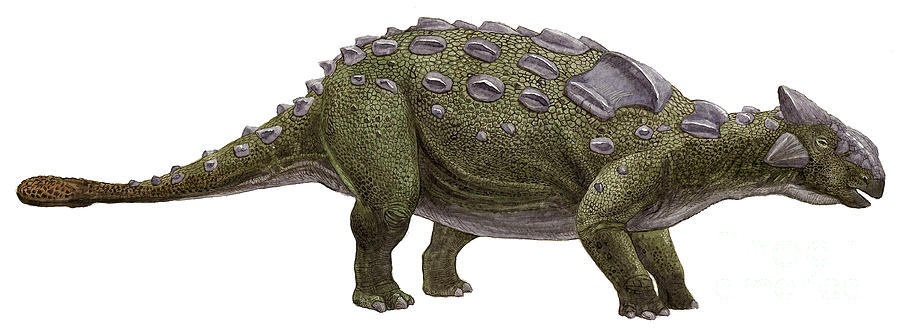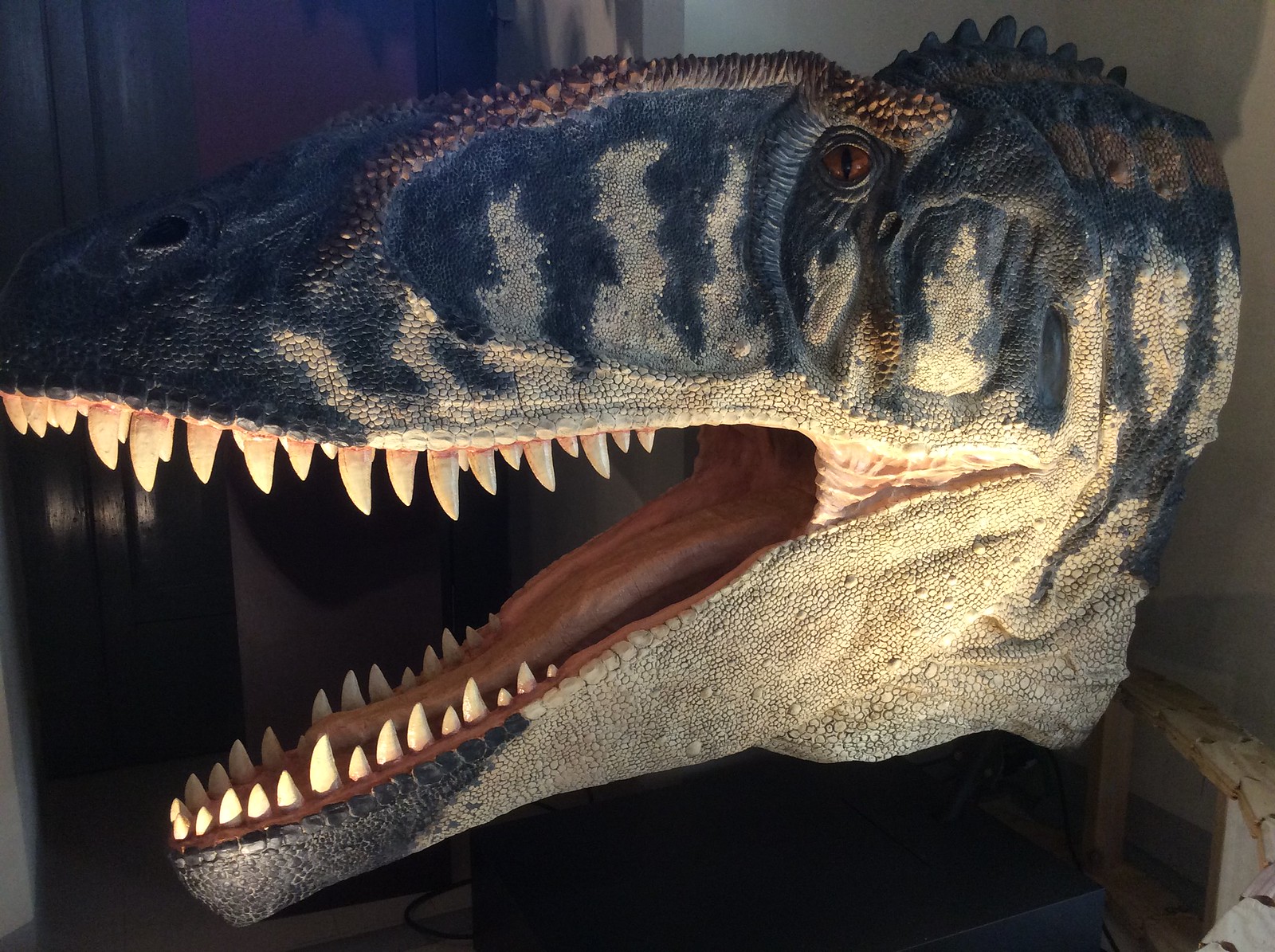Post by Infinity Blade on Apr 18, 2014 20:08:15 GMT 5
Ankylosaurus magniventris
Ankylosaurus (/ˌæŋkɨlɵˈsɔrəs/ ang-ki-lo-sawr-əs or /æŋˌkaɪlɵˈsɔrəs/ ang-ky-lo-sawr-əs, and which means "fused lizard") is a genus of ankylosaurid dinosaur, containing one species, A. magniventris. Fossils of Ankylosaurus are found in geologic formations dating to the very end of the Cretaceous Period (between about 66.5–66 Ma ago) in western North America. Although a complete skeleton has not been discovered and several other dinosaurs are represented by more extensive fossil material, Ankylosaurus is often considered the archetypal armored dinosaur. Other ankylosaurids shared its well-known features—the heavily armored body and massive bony tail club—but Ankylosaurus was the largest known member of the family. Ankylosaurus (/ˌæŋkɨlɵˈsɔrəs/ ang-ki-lo-sawr-əs or /æŋˌkaɪlɵˈsɔrəs/ ang-ky-lo-sawr-əs, and which means "fused lizard") is a genus of ankylosaurid dinosaur, containing one species, A. magniventris. Fossils of Ankylosaurus are found in geologic formations dating to the very end of the Cretaceous Period (between about 66.5–66 Ma ago) in western North America. Although a complete skeleton has not been discovered and several other dinosaurs are represented by more extensive fossil material, Ankylosaurus is often considered the archetypal armored dinosaur. Other ankylosaurids shared its well-known features—the heavily armored body and massive bony tail club—but Ankylosaurus was the largest known member of the family. The most obvious feature of Ankylosaurus is its armor, consisting of massive knobs and plates of bone, known as osteoderms or scutes, embedded in the skin. Osteoderms are also found in the skin of crocodiles, armadillos and some lizards. The bone was probably overlain by a tough, horny layer of keratin. These osteoderms ranged greatly in size, from wide, flat plates to small, round nodules. The plates were aligned in regular horizontal rows down the animal's neck, back, and hips, with the many smaller nodules protecting the areas between the large plates. Smaller plates may have been arranged on the limbs and tail. Compared to the slightly more ancient ankylosaurid Euoplocephalus, the plates of Ankylosaurus were smooth in texture, without the high keels found on the armor of the contemporaneous nodosaurid Edmontonia. A row of flat, triangular spikes may have protruded laterally along each side of the tail. Tough, rounded scales protected the top of the skull, while four large pyramidal horns projected outwards from its rear corners. The famous tail club of Ankylosaurus was also composed of several large osteoderms, which were fused to the last few tail vertebrae. It was heavy and supported by the last seven tail vertebrae, which interlocked to form a stiff rod at the base of the club. Thick tendons have been preserved, which attached to these vertebrae. These tendons were partially ossified (or bony) and were not very elastic, allowing great force to be transmitted to the end of the tail when it was swung. It seems to have been an active defensive weapon, capable of producing enough of a devastating impact to break the bones of an assailant. A 2009 study showed that "large tail knobs could generate sufficient force to break bone during impacts, but average and small knobs could not", and that "tail swinging behavior is feasible in ankylosaurids, but it remains unknown whether the tail was used for interspecific defense, intraspecific combat, or both". It has also been proposed that the tail club acted as a decoy for the head, although this idea is now largely discredited.

Edmontonia spp.
Edmontonia was an armoured dinosaur, a part of the nodosaur family from the Late Cretaceous Period. It is named after the Edmonton Formation (now the Horseshoe Canyon Formation), the unit of rock it was found in. Edmontonia was bulky and tank-like at roughly 6.6 m (22 ft) long and 2 m (6.5 ft) high. It had small, ridged bony plates on its back and head and many sharp spikes along its back and tail. The four largest spikes jutted out from the shoulders on each side, two of which were split into subspines in some specimens. Its skull had a pear-like shape when viewed from above. (Compare 26 feet long and 8 feet high for the M1 Abrams army tank.)

Credit goes to Durbed for the Edmontonia illustration.
Ankylosaurus (/ˌæŋkɨlɵˈsɔrəs/ ang-ki-lo-sawr-əs or /æŋˌkaɪlɵˈsɔrəs/ ang-ky-lo-sawr-əs, and which means "fused lizard") is a genus of ankylosaurid dinosaur, containing one species, A. magniventris. Fossils of Ankylosaurus are found in geologic formations dating to the very end of the Cretaceous Period (between about 66.5–66 Ma ago) in western North America. Although a complete skeleton has not been discovered and several other dinosaurs are represented by more extensive fossil material, Ankylosaurus is often considered the archetypal armored dinosaur. Other ankylosaurids shared its well-known features—the heavily armored body and massive bony tail club—but Ankylosaurus was the largest known member of the family. Ankylosaurus (/ˌæŋkɨlɵˈsɔrəs/ ang-ki-lo-sawr-əs or /æŋˌkaɪlɵˈsɔrəs/ ang-ky-lo-sawr-əs, and which means "fused lizard") is a genus of ankylosaurid dinosaur, containing one species, A. magniventris. Fossils of Ankylosaurus are found in geologic formations dating to the very end of the Cretaceous Period (between about 66.5–66 Ma ago) in western North America. Although a complete skeleton has not been discovered and several other dinosaurs are represented by more extensive fossil material, Ankylosaurus is often considered the archetypal armored dinosaur. Other ankylosaurids shared its well-known features—the heavily armored body and massive bony tail club—but Ankylosaurus was the largest known member of the family. The most obvious feature of Ankylosaurus is its armor, consisting of massive knobs and plates of bone, known as osteoderms or scutes, embedded in the skin. Osteoderms are also found in the skin of crocodiles, armadillos and some lizards. The bone was probably overlain by a tough, horny layer of keratin. These osteoderms ranged greatly in size, from wide, flat plates to small, round nodules. The plates were aligned in regular horizontal rows down the animal's neck, back, and hips, with the many smaller nodules protecting the areas between the large plates. Smaller plates may have been arranged on the limbs and tail. Compared to the slightly more ancient ankylosaurid Euoplocephalus, the plates of Ankylosaurus were smooth in texture, without the high keels found on the armor of the contemporaneous nodosaurid Edmontonia. A row of flat, triangular spikes may have protruded laterally along each side of the tail. Tough, rounded scales protected the top of the skull, while four large pyramidal horns projected outwards from its rear corners. The famous tail club of Ankylosaurus was also composed of several large osteoderms, which were fused to the last few tail vertebrae. It was heavy and supported by the last seven tail vertebrae, which interlocked to form a stiff rod at the base of the club. Thick tendons have been preserved, which attached to these vertebrae. These tendons were partially ossified (or bony) and were not very elastic, allowing great force to be transmitted to the end of the tail when it was swung. It seems to have been an active defensive weapon, capable of producing enough of a devastating impact to break the bones of an assailant. A 2009 study showed that "large tail knobs could generate sufficient force to break bone during impacts, but average and small knobs could not", and that "tail swinging behavior is feasible in ankylosaurids, but it remains unknown whether the tail was used for interspecific defense, intraspecific combat, or both". It has also been proposed that the tail club acted as a decoy for the head, although this idea is now largely discredited.

Edmontonia spp.
Edmontonia was an armoured dinosaur, a part of the nodosaur family from the Late Cretaceous Period. It is named after the Edmonton Formation (now the Horseshoe Canyon Formation), the unit of rock it was found in. Edmontonia was bulky and tank-like at roughly 6.6 m (22 ft) long and 2 m (6.5 ft) high. It had small, ridged bony plates on its back and head and many sharp spikes along its back and tail. The four largest spikes jutted out from the shoulders on each side, two of which were split into subspines in some specimens. Its skull had a pear-like shape when viewed from above. (Compare 26 feet long and 8 feet high for the M1 Abrams army tank.)

Credit goes to Durbed for the Edmontonia illustration.












